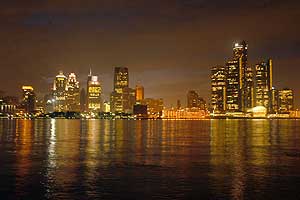We Want Walkability
The demand for walkable urban living is “in the air.” Christopher B. Leinberger, an urban strategist and real estate expert, says downtown Detroit is poised to offer the kind of city living that more and more people desire.
A sign advertises lofts coming soon in “downtown” Port Austin, a tiny farm and tourist town that sits on the tip of Michigan’s thumb. That type of development doesn’t surprise Christopher B. Leinberger, an urban land strategist, developer, teacher and researcher, who says walkable urbanity is catching on.
“It’s in the air. It’s in the water,” says Leinberger. “It’s the generation that was raised on Seinfeld, Friends and Sex in the City.”
 A visiting fellow at the Brookings Institution, and the
A visiting fellow at the Brookings Institution, and the
head of the University of Michigan’s new graduate real estate program, Leinberger is one of
many experts who will discuss walkability at the upcoming University of Michigan/Urban Land Institute real estate forum held this year at Cobo
Center in Detroit.
Leinberger, who lives in Washington, D.C., recently spent some time
with Model D musing about Detroit. From the window in the office where
we sat talking, we could see thousands of Tigers’ fans packed into the
stadium for a day game. An unexpected comeback seemed an appropriate
place to start the conversation.
Model D: What are some of the things that make downtown Detroit well positioned to come back?
Christopher Leinberger: The most obvious thing is the tremendous investment in urban entertainment, and that includes obviously the ballparks, the gaming casinos, the nightclubs, the restaurants. … So there’s a lot of great urban entertainment — the Opera House, the Fox Theatre, the possibility that the Ilitches are talking about with a new hockey arena. And all those things are coming downtown, which is where they should be. …
MD: So one of the reasons that we are well positioned here is that we have all the big entertainment assets here, downtown.
CL: You made all the right decisions. There is not a wrong decision I can see that this metropolitan area has made regarding downtown over the last five, six or seven years.
MD: I don’t know how long you’ve been familiar downtown Detroit. Have you noticed the changes down here?
CL: I was on the board of a suburban Detroit real estate firm, Etkin Equities, … I would stay downtown at the Atheneum and ride the People Mover, just to get a feel for this downtown. In the ’90s it was pretty bleak, but this is a whole different story.
MD: I’ve heard you say that the market wants what downtowns offer.
 CL: The market wants walkable urbanity. And walkable urbanity — which is simply that within 1,500 feet there’s a lot of stuff to do — can show up in Royal Oak, Ann Arbor, Birmingham, and downtown or Midtown Detroit.
CL: The market wants walkable urbanity. And walkable urbanity — which is simply that within 1,500 feet there’s a lot of stuff to do — can show up in Royal Oak, Ann Arbor, Birmingham, and downtown or Midtown Detroit.
Consumer research divides the world into three categories: Folks that want walkable urbanity; folks that want what I refer to as drivable suburbanism; and folks that don’t know what they want. The research shows that 30-40 percent of us, depending on the metropolitan area, want drivable suburbanism; 30-40 percent want walkable urbanity; and 30 percent can’t figure out what they want. If you’ve got 30-40 percent that want walkable urbanity, here in the Detroit metropolitan area like 5 percent of the housing stock is in a walkable environment — and I’m trying to be generous.
MD: If there’s so much demand for walkable neighborhoods, why only 5 percent here?
CL: There is this pendulum. For years and years, this would be in your great-grandfather’s era, they didn’t have a choice but to live in walkable urbanity — they didn’t have cars, or very few cars. They had streetcars or you walked around. Life was much more confined. … It just came naturally that we built cities for thousands of years that were walkable.
We then discovered that there was another way of doing things. So we take the pendulum and push it all the way over. It became our domestic policy as a country — it really was a giant social engineering experiment where we said we were going to subsidize it, we were going to make it the only thing legal to build. Mixed-use walkable product became illegal, and is illegal in most jurisdictions here in this state. We said we are only going to finance and buy and trade this kind of product that is drivable. So, we in real estate really just learned that product. …
We’re now pushing the pendulum back and it’s for simple reasons. Bernie Gleiberman (of Detroit’s Crosswinds Communities) said it best last week at lunch: The bright spot in the Michigan real estate market right now is the city of Detroit. Last year the city of Detroit led the state in building permits. Last year was the first year in I bet three decades where building permits outnumbered demolition permits. Demolition permits, by the way, are mostly single-family homes. Building permits are mostly mult-family homes. So, things are changing.
MD: More people seem to want to live around density, too.
CL: We now know that drivable suburbanism, as you build more, you get less quality of life. The very things that you build suburbia for get consumed by surburbia. That’s why there’s that joke that’s been around for hundreds of years that suburban subdivisions are named after what they destroy. You know, Spring Hollow, built on top of the spring. … But the nature of it is that more is less.
MD: Is the converse true in the city?
CL: Yes, more is better. As you add more density, as you get more people on the street, as you add more restaurants, it just gets richer. It just gets more exciting.
MD: We talked about Detroit’s changes over the past 5-6 years, which in the lifespan of a city is a drop in the bucket. But many people in Detroit want to see what’s going on downtown spread into neighborhoods faster, and they want to see more happen quicker. But it still seems like we are at the beginning of all this in Detroit.
CL: There’s a scale that I use to judge where cities are, Lead is the worst — you’re beyond that. Copper is where you guys are, maybe Copper-plus, moving toward Silver. You’re not at critical mass until you turn to Gold, and you’ve got a good 5-10 years yet.
MD: How many Gold cities are there?
 CL: There’s plenty. I couldn’t say that 10, 15 years ago. But in the last 10 years, San Diego, Portland, Seattle, Denver, Chattanooga, Baltimore, downtown D.C., all these towns got critical mass.
CL: There’s plenty. I couldn’t say that 10, 15 years ago. But in the last 10 years, San Diego, Portland, Seattle, Denver, Chattanooga, Baltimore, downtown D.C., all these towns got critical mass.
MD: To what extent does metro Detroit need to recognize that the city should be the center of the region?
CL: It’s a very important time right now, partly because the Detroit area realizes that the car industry is not their only salvation. So in this adjustment period that you are going through, as Bernie Gleiberman said, the only interesting, vibrant market right now is downtown Detroit.
So I think metro Detroiters will realize it by hook or by crook, because the market wants it, it’s coming back, and there’s not that much else happening. But the other reason I hope they would realize it is that if 30-40 percent of us want something, and you don’t offer it, from an economic development point of view, you’re out of luck.
The UM/ULI Real Estate Forum will be held Oct. 26-27 at Cobo Hall in Detroit. In addition to Christopher Leinberger, speakers include Albert B. Ratner of Forest City Enterprises, Richard D. Baron with McCormzack Baron Salazar and Paul R. Levy with Philadelphia’s Center City District. For more information, or to register for the event, go the forum’s Web site.
Chris Leinberger and Downtown Detroit Photos Copyright Dave Krieger





